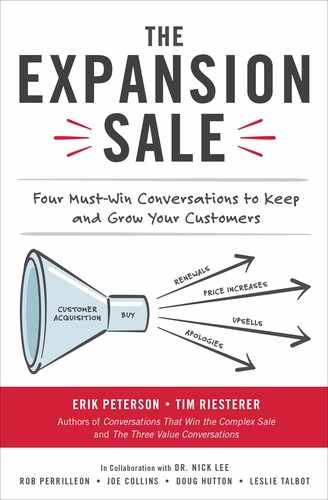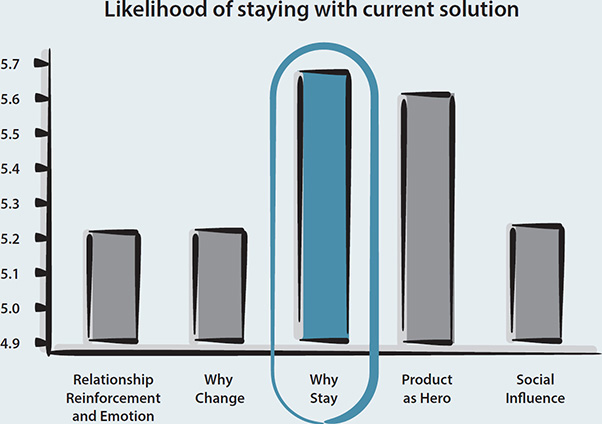 7
7 
The Winning Why Evolve Message Framework
For the Why Evolve research, we continued our collaboration with Dr. Nick Lee of Warwick Business School. The mission: Develop a message framework that supports the effort to sell upgraded or add-on solutions and services to existing customers.
Here’s how we set it up:
At the outset, participants were randomly assigned to one of five test conditions. They were then told to imagine they were the decision maker in a discussion with a sales representative from their longstanding software vendor. The rep is trying to convince them to upgrade from a legacy, on-premise version of their business intelligence software to their new cloud-based business analytics solution.
The five conditions reflected the following message types:
1. Product as Hero. This is the model many companies use to announce new solutions. It’s product-oriented, focusing heavily on new and improved features and benefits.
2. Why Change. This message is provocative and edgy and has already proved effective in unseating an incumbent and converting prospects to customers. But would it work in a Why Evolve scenario?
3. Why Stay. Our previous research proved this message is most effective in convincing existing customers to renew at the end of a contract. But how would it hold up in the middle of the contract when an upsell is hanging in the balance?
4. Relationship Reinforcement and Emotion. This “hybrid” of Why Change and Why Stay uses strong emotional language to emphasize the partnership between the customer and the vendor, while at the same time initiating a frank conversation about shared challenges and opportunities.
5. Social Influence. This message deploys peer pressure as a powerful motivator, attempting to show the buyers that many of their peers are taking these same actions and they can’t afford to be left behind.
As in our other experiments, participants experienced only one of the five conditions. Afterward, they were asked to respond with numerical scores to a series of questions aligned to the five key challenges outlined in the previous chapter. The responses were then averaged to form a composite index for each assessed area.
WHY EVOLVE: THE RESULTS
In a combined score reflecting the overall performance of each message across all positive areas assessed in the study, the message that performed best was Scenario #4: The hybrid “Relationship Reinforcement and Emotion” condition. This message outperformed the others by a range of 4.3–5.8 percent (Figure 7.1).
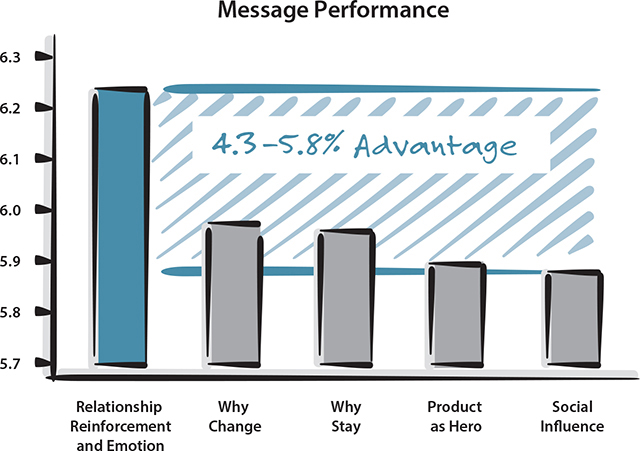
Figure 7.1 The hybrid Relationship Reinforcement and Emotion message carried the day—outperforming the others by up to 5.8 percent.
We also explored how well each message answered the five critical questions detailed in Chapter 6. Once again, the Relationship Reinforcement and Emotion condition outperformed the others across all five areas—in this case, by an even more significant effect size (Figures 7.2–7.6).
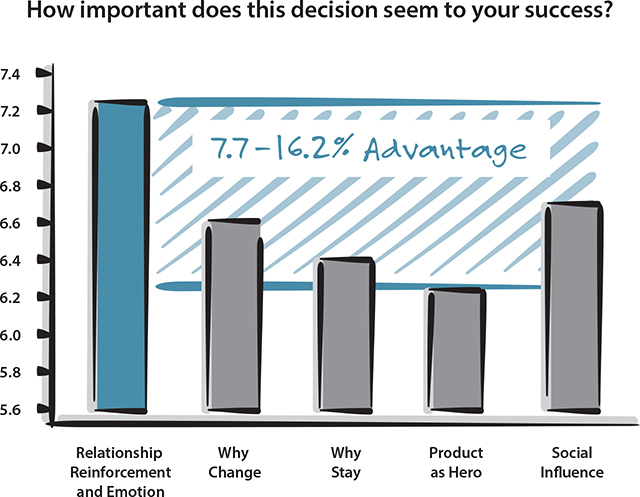
Figure 7.2
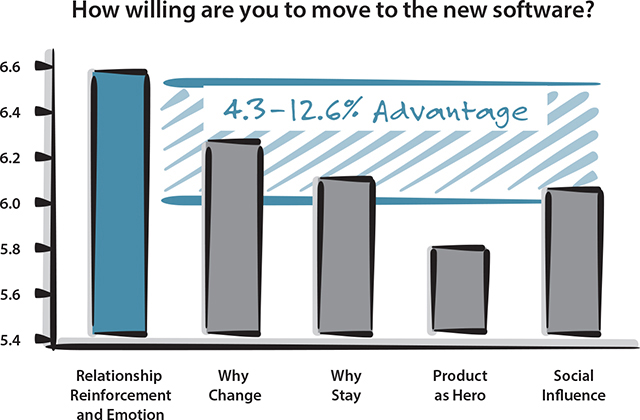
Figure 7.3
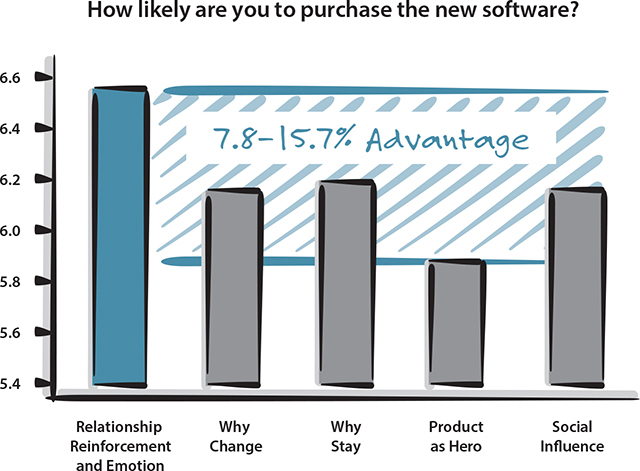
Figure 7.4
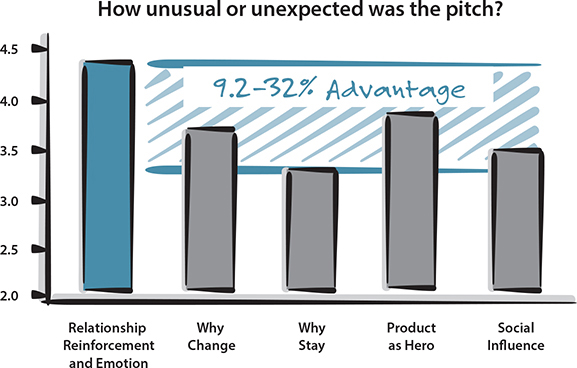
Figure 7.5
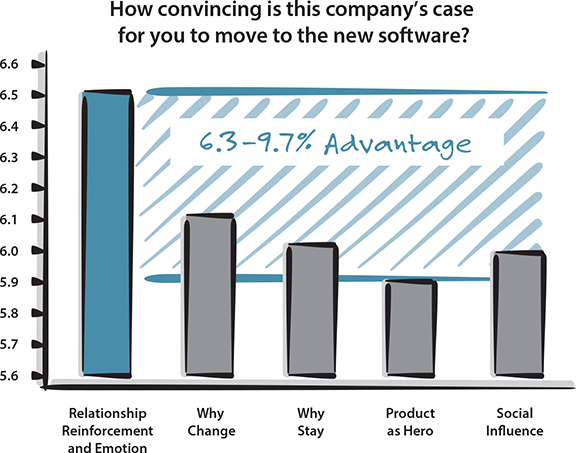
Figure 7.6
Figures 7.2–7.6 The Relationship Reinforcement and Emotion condition outperformed all other conditions across the five critical areas tested—importance to success, willingness to move to new software, likelihood to purchase, unusualness or unexpectedness of pitch, and convincing case to purchase.
It’s worth calling out the poor performance of the “Product as Hero” condition, which underperformed all other conditions in several key categories, including “willingness to move to the new software” and “likelihood to purchase the new software”—in other words, the very actions a Why Evolve message is supposed to drive.
It’s all the more puzzling, because as noted in Chapter 6, this is the preferred approach for many companies seeking to upgrade their customers. They lean heavily into the product message, assuming that the appeal of the “new” is enough to entice customers to buy more.
But think about this for a moment. Experienced marketers and sellers have long known that buyers hate straight product pitches, and they should know better than to deliver them. Yet for some reason, when it comes to positioning upgrades, all that wisdom goes right out the window—they are perfectly comfortable positioning the new capabilities as the main reason the customer should make the change. In fact, sellers often dress up the pitch as a favor to the customer: “I just went through some training on our latest solution, and I immediately thought of you. I think it would be a great fit in your environment, and I would love to talk to you about it.”
It’s great that you are thinking about your customers. They might be flattered that you thought of them. And they might even be impressed with your long list of cool features. But until you put those features into the proper context—by framing their needs within the right message choreography—they’re simply not going to care enough to move.
THE WINNING MESSAGE: THE “HYBRID” (RELATIONSHIP REINFORCEMENT AND EMOTION)
The Relationship Reinforcement and Emotion condition (Figure 7.7) performed best in the study.
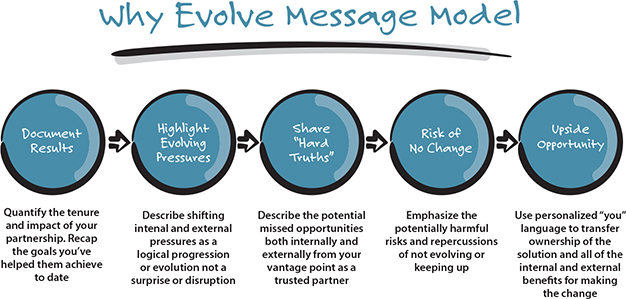
Figure 7.7 Use the Why Evolve message model to sell upgraded or add-on solutions and services to existing customers.
Here’s the winning message, along with our analysis of why each element performed the way it did.
1. Document results. Over our nine-year partnership, we have worked together toward your goals of creating organizational efficiency, increasing customer satisfaction, and protecting and growing revenue.
As with the Why Stay message framework, the most effective opening move is to reinforce the relationship by showing all the great things you and your customers have done together. 83And just as in Why Stay, some underperformance is okay as long as you’re showing some progress toward the customers’ goals and not simply focusing on the metrics you performed best on.
2. Highlight evolving pressures. As with anything else, business needs change and technologies evolve. Externally you face a customer base that wants personalized solutions and instant answers. Internally you have a changing workforce that wants the newest tools and greater work flexibility.
This is where you see the first signs of the hybrid message. You want to raise the idea of change; otherwise, there’s no reason for the customers to do anything different. At the same time, you don’t want to introduce anything so radical it would drive them to investigate other options. Describing the evolving pressures as a logical progression of their current state creates just enough disruption without sacrificing your Incumbent Advantage.
3. Share “hard truths.” As partners, it’s tempting just to focus on all the positives, but the role of a good partner is to also share hard truths. The fact is, we’ve heard from your teams that they like our software, but they are frustrated at having to dedicate time consolidating data from different sources. Then once the data is consolidated in your system, they feel limited because your current version has a limited set of standard reporting views available.
This is the most delicate step in the Why Evolve conversation, but it’s also the most critical. Hard truths are the gaps and shortfalls in your customer’s current approach—the approach you helped construct. It takes a lot of transparency and some vulnerability to reveal this to the customer, but that’s also what makes it so powerful. When you are part of the status quo, you can’t just tell your clients they’re falling behind and are on a quick road to irrelevance. What you can do, however, is point to the emerging trends you discussed in the previous step and acknowledge where your solution falls short. Of course, you know your new solution will help close those gaps.
4. Emphasize risk of no change. These areas of inefficiency can make it difficult for your hardworking teams to identify areas of waste, which means the organization continues to waste time. Not only does this make your employees frustrated and dissatisfied, but it can lead to clients becoming irritated that they aren’t getting the personalized information and immediate experiences they desperately crave. This frustration has the potential to lead to more employee turnover and less customer loyalty.
Risk is a powerful human motivator. As you saw in Chapter 1, people are two to three times more likely to change to avoid loss than to achieve a gain, so any new message you deliver must contain a frank explanation of the risk your customer faces, as opposed to a litany of benefits. The balancing act is that you have to present this risk in a way that won’t make your customers feel that you as a vendor are the source of the risk.
5. Describe upside opportunity. But you can ensure your team has the latest version of the software that is so critical to your business. By upgrading to our new cloud-based solution, you’ll get faster, simpler, and more flexible business management capabilities that allow you to acquire and analyze multiple data sources easily from a single app. You’ll also tap into the power of artificial intelligence and be able to produce more than 50 standard reports that can be customized to your business. All this to improve the speed of your operations, the usefulness of your insights, while increasing both internal team and external customer satisfaction.
In good messaging, you can’t just tell people what they shouldn’t do; you also need to give them a strategy for what they should do. Show them what their world will be like by helping them envision themselves using your solution and being successful with it. In this choreography, your solution is simply the means to that end. If the message is done right, this should not feel like a revolutionary change from their current state, but more a logical evolutionary next step.
The consistently strong performance of the hybrid message framework across all meaningful areas confirmed our hypothesis that the upsell moment calls for a different type of message than either the provocative Why Change or the protectionist Why Stay model. It’s neither a straight acquisition nor a status quo reinforcement message; rather, it combines elements of each to exploit your Incumbent Advantage while still making the case for change.
This makes sense when you consider that the goal of this message isn’t to drive a big change, nor is it about getting the customers to renew an existing solution. It’s about getting the customers to evolve—to embrace change, but only as a logical progression of their ongoing pursuit of their goals. This “controlled change” messaging ensures they won’t stagnate, but will instead embrace your innovations with confidence and enthusiasm.
